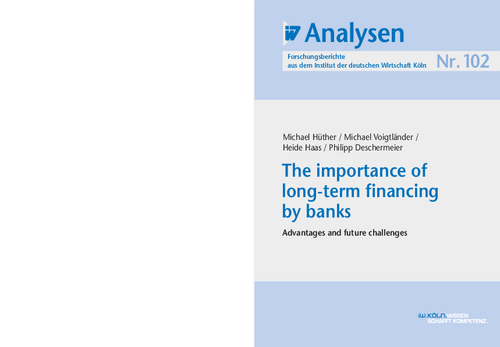Advantages and future challenges

The importance of long-term financing by banks
IW-Analysis

Advantages and future challenges
The new financial market regulations that have been drawn up in the wake of the financial market crisis will drastically alter lending conditions for banks. The key aim is to make the financial system less susceptible to crisis and to avoid future state intervention due to the insolvency of banks that can affect the whole system. This is an understandable aim. Basel III and Solvency II will be able to help ensure that banks and insurance companies become more robust in future. However, questions are increasingly being asked as to whether banks will stay as efficient in future, and in particular whether they will still be able to fulfil their economic functions. Their ability to offer long-term lending seems particularly at risk, for example as shown in the European Commission’s green paper on long-term financing. The European Commission is therefore proposing that long-term financing should in future be shifted increasingly to other financial intermediaries, such as insurance companies and funds.
This constitutes the starting point for the following analysis, which will focus mainly on three important questions:
- What is the importance of long-term financing to the real economy?
- Can alternative financial intermediaries replace banks in long-term financing?
- What will long-term financing by banks look like under the new rules andwhat adjustments must be made to regulations to ensure that banks can stillfunction?
Section 3 looks at the importance of long-term financing to the real economy. It is based on the housing market, which is not only extremely important in terms of volumes, but also provides sufficient data for an international comparison. As we will see, there are considerable differences in how housing markets are financed in different countries. For example, while longterm fixed interest rates prevail in Germany, most loans in the United Kingdom are subject to variable interest rates. These differences have a significant impact on the stability of the housing markets. Markets that are dominated by long-term financing experience considerably lower price volatility than other markets. This is because interest-rate volatility has less of an impact on demand. Such correlations can in principle also be applied to other markets although variations in corporate financing, for example, are much greater even within the same country. The fact that the advantages of long-term financing in terms of macroeconomic stability are not being exploited everywhere is due to its costs, which are largely determined by the regulatory
framework and economies of scale when providing financing, and also by individual preferences. Short-term loans are often particularly prevalent in countries with lower savings ratios, in part because households and companies want to retain a degree of flexibility.
Section 4 discusses which financial intermediaries are able to offer longterm loans. It looks firstly at banks, whose economic functions involve bringing together savers and investors and maturity transformation. Banks also have a broad mix of funding available to them, which opens up the option of long-term lending in a special way. Long-term loans can generally be funded through deposits, bonds or asset-backed securities (ABS). These types of funding are available in all the countries analysed, although the weightings vary. If a corresponding demand arises, banks can thus grant long-term loans in all countries. However, historical analysis also shows that long-term financing must first become established, i.e. it requires market participants to have appropriate experience.
Banks have structural advantages over other financial intermediaries when it comes to long-term financing. The size of their loan portfolios makes it easier for them to transform lot sizes and balance differences in maturities, which means that they can, on average, offer loans at more favourable conditions. They also specialise in credit checks and risk monitoring. Although insurance companies can also provide loans, lending is only ever one of numerous investments for them, as their aim is to diversify their portfolio. Insurance companies therefore generally cooperate with banks when they provide loans. Essentially this also applies to credit funds and other alternative providers whose size puts them at a disadvantage compared with banks. Furthermore, funds generally lack long-term capital providers, which are necessary for longterm financing. All things considered, alternative financial intermediaries will not be able to replace banks, but will mainly be able to complement them. In particular, they can improve banks’ funding by purchasing covered bonds or ABS while simultaneously playing a part in the risk- return profile for lending.
Nevertheless, the level of lending by alternative providers of financing is likely to increase in future. This is due to regulations, which favour these providers over classic financing providers. Section 5 focuses on this. The unweighted leverage ratio and net stable funding ratio (NSFR) agreed as part of CRD IV (Capital Requirements Directive) have proved to be an impediment to long-term financing by banks. The unweighted leverage ratio constitutes a restriction on volumes that particularly affects specialist lenders focusing on low-risk, long-term financing for real estate and regional authorities. Margins are much lower in this area of business than in investment banking, which is why it is difficult to attract additional providers of capital under the current conditions. These institutions are reducing their balance sheets as a result, which also weakens long-term financing. The NSFR also offers incentives to reduce loan maturities. Furthermore, the new international accounting standards (IFRS 9) issued by the International Accounting Standards Board will increase the provisioning required for long-term lending. Solvency II will also reduce demand for long-term bonds among insurance companies, making long-term funding more difficult.
Other financial intermediaries are less tightly regulated. This offers incentives for a shift in lending, but also leads to new risks. The stability of the financial system will ultimately not increase if banks become more stable but new risks arise in less regulated areas. On the contrary, while there is a wealth of experience in assessing incipient banking crises, the situation in the shadow banking sector is much more difficult to assess.
What is needed is therefore a uniform level playing field, i.e. a standardised framework for financial intermediaries. The application of Basel III must also be reviewed. Both the unweighted leverage ratio and the NSFR are measurements that offer only an indirect indication of the probability of insolvency. These ratios should therefore be used in a less restrictive way and instead should serve as monitoring ratios. A more extensive investigation can then begin in the event of any deviations from the expected levels. Although more separate analyses would probably lead to higher regulatory and supervisory costs, a uniform approach cannot be justified in view of the multitude of different business models. Crucially, however, the cost of a reduction in long-term financing for the real economy would be much higher.

Michael Hüther / Michael Voigtländer / Heide Haas / Philipp Deschermeier: The importance of long-term financing by banks – Advantages and future challenges
IW-Analysis

More on the topic

Recommendations for Increasing Investment in Climate Protection
Germany has set itself ambitious goals for climate protection in its buildings, with the building stock expected to be almost climate-neutral by 2050. This will require extensive refurbishment of almost all residential and commercial properties.
IW